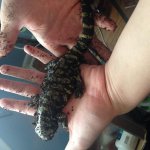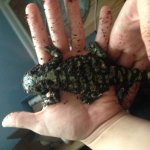Hello,
one of my salamanders has been down deep in the dirt for a month now. I dug her up a couple weeks ago and she refused to eat. I was kind of scared to look for her again cause I didn't know what I would find but here she is alive and all however she just doesn't look right. Her and seems a little puffed up for not having eaten and usually she is the first to get the worms and always at the surface. I feed them earth worms, they stay in a 20 gal tank with coconut fiber soil and living plants.
one of my salamanders has been down deep in the dirt for a month now. I dug her up a couple weeks ago and she refused to eat. I was kind of scared to look for her again cause I didn't know what I would find but here she is alive and all however she just doesn't look right. Her and seems a little puffed up for not having eaten and usually she is the first to get the worms and always at the surface. I feed them earth worms, they stay in a 20 gal tank with coconut fiber soil and living plants.


